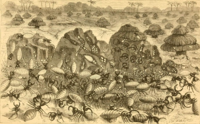Komposit-Wesen
Biologie
Definition
Als Komposit-Wesen bezeichnen verschiedene Autoren aus mehreren erkennbaren Einzelindividuen zusammengesetzte Indiviuden. Dazu stehen hier einige Beispiele.
Eugene Marais
Im Jahr 1925 veröffentlichte der südafrikanische Naturphilosoph Eugene Marais das Buch "The Soul of the White Ant"[1]. Darin beschreibt er Termitenstaaten als eigene individuelle Lebensformen. Dieser Gedanke ist in einem eigenen Kapitel mit dem Titel "The Development of the Composite Animal" ausgearbeit: "I have taken great pains to prove that the termitary is a separate and composite animal in exactly the same way that man is a separate composite animal. [...] The insects themselves shold always be thought of as the blood-stream and organs of a single animal". Mehr unter The Soul of the White Ant ↗
Olaf Stapledon
In seinem Sci-Fi-Klassiker "Der Sternenschöpfer"[2] aus dem Jahr 1937 beschreibt der Philosoph Olaf Stapledon fremdartige Lebensformen auf fernen Planeten. In einem eigenen Kapitel schreibt er über composite beings, auf deutsch Komposit-Wesen: "Sometimes in the course of our adventure we came upon worlds inhabited by intelligent beings, whose developed personality was an expression not of the single individual organism but of a group of organisms. [...] In such worlds the organic basis of intelligence was often a swarm of avian creatures no bigger than sparrows. A host of individual bodies were possessed together by a single individual mind of human rank. The body of this mind was multiple, but the mind itself was almost as firmly knit as the mind of a man." Siehe auch Star Maker ↗
Fußnoten
[1] Eugène N. Marais: The Soul of the White Ant. Zuerst verfasst auf Afrikaans unter dem Titel: Die Siel van die Mier. Im Jahr 1937 ins Englische übersetzt von Winifred de Kok. Londoner Ausgabe von 1971 vom Verlag Jonathan Cape and Anthony Blond. ISBN: 0 224 61871 7
- [2] Olaf Stapledon: Der Sternenmacher auch: Der Sternenschöpfer, 1966, ISBN 3-453-30795-X, Star Maker, 1937
